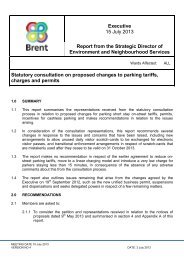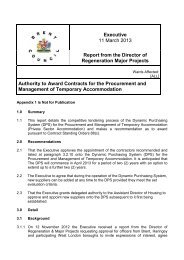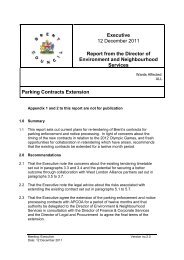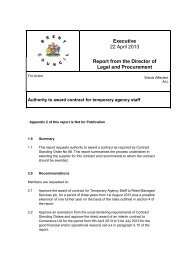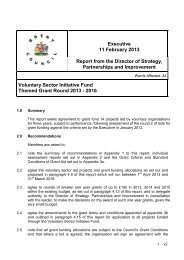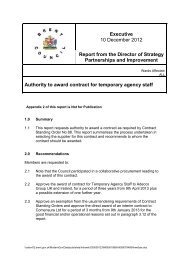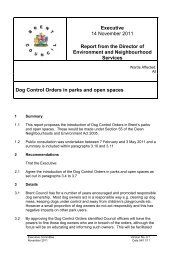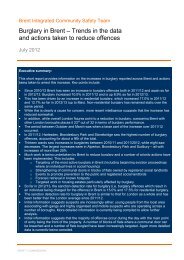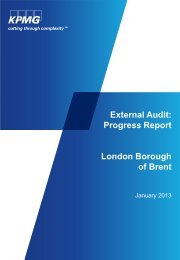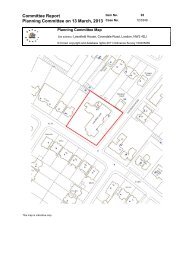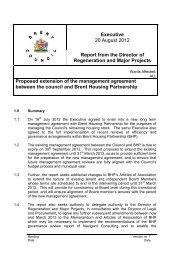wembley-plan-app (small) , item 9. PDF 8 MB - Meetings, agendas ...
wembley-plan-app (small) , item 9. PDF 8 MB - Meetings, agendas ...
wembley-plan-app (small) , item 9. PDF 8 MB - Meetings, agendas ...
- No tags were found...
You also want an ePaper? Increase the reach of your titles
YUMPU automatically turns print PDFs into web optimized ePapers that Google loves.
80Wembley Area Action Plan - Proposed Submission Version7 HousingSupported Housing7.23 Supported housing need in the boroughaccommodates a wide range of client groups, whichinclude some of the most vulnerable people in theborough, including frail elderly people andindividuals and households with multiple, complexneeds. The provision of new care and supportaccommodation, as well as the remodelling ofexisting facilities to enable people to live moreindependently, is a strategic priority for the borough.As the lead growth area, Wembley is expected todeliver a new supply of predominantlyself-contained one and two bedroomaccommodation that can help address these needs.Extra Care Housing7.24 Brent’s Extra Care Housing Strategyidentifies demand for 300 units of Extra Careaccommodation over the period 2010-15. ExtraCare housing comprises self-contained homes withdesign features and support services available toenable self-care and independent living, with thelevel of care and support tailored to individualneeds. Extra care housing is popular with peoplewhose disabilities, frailty or health needs makeordinary housing unsuitable but who do not needor want to move to long term care in the form ofresidential or nursing homes. Older people makeup the majority of users of Extra Care. However,people with disabilities that are not age related areincreasingly making use of this type of housing.20 units are currently under construction at CharlesGoddard House, High Road, Wembley. The onlyother site in the Wembley area identified for extracare housing is in Vivien Avenue. The most suitablesites within the Action Plan area are likely to bethose on the periphery of the main regenerationarea, such as in the North-East District shown inthe Master<strong>plan</strong>, where amenity and access to openspace are better. An example of such a site, shouldhousing development be brought forward, is WatkinRoad (see site proposal WEM 26).WEM 22Extra Care HousingAn element of extra care housing will besought on <strong>app</strong>ropriate sites. These willgenerally be sites where proposeddevelopment is primarily residential, whereresidential amenity is good and where it is nearto open space.Housing Needs of Disabled People7.25 Information from the 2001 Census indicatesthat 15.6% of Brent’s population and 14.6% of theWest London population had a limiting long termillness or disability.7.26 The West London Strategic Housing MarketAssessment refers to recent Local Authority surveydata in West London that indicates that 14% of allhouseholds contain someone who has a specialneed, including <strong>9.</strong>3% of households whichcontained at least one member with a physicaldisability. Other special needs groups prevalent inhouseholds include frail elderly people, as well aspeople with mental health problems, impaired sightor hearing, and people with learning disabilities.7.27 In line with London Plan policy 3.8, Brentrequires all homes be built to Lifetime Homesstandards and 10% to be wheelchair accessible oreasily adaptable for residents who are wheelchairusers. This will be <strong>app</strong>lied to all relevant proposalsin Wembley. Where there is an ostensible difficultyor failure in the private sector to deliver more thanonly new homes easily adaptable for residents whoare wheelchair users, the council may take theposition of concentrating wheelchair housing in newaffordable homes in order to provide fullywheelchair accessible housing for physicallydisabled people.7.28 Loss of existing supported housing schemeswill be resisted under Core Strategy policy CP21,which protects existing accommodation that meetsknown needs. In such cases where existing facilitiescater for a particular supported housing need forwhich there is currently no demand, efforts shouldbe made to remodel and adapt such facilities tocurrent supported housing needs. More generally,new supported housing facilities should bedesigned wherever possible with a view to flexibilityand the need to adapt to changing and futurepatterns of supported housing demand.



